人教版新课标选修六第一单元
- 格式:ppt
- 大小:7.95 MB
- 文档页数:15
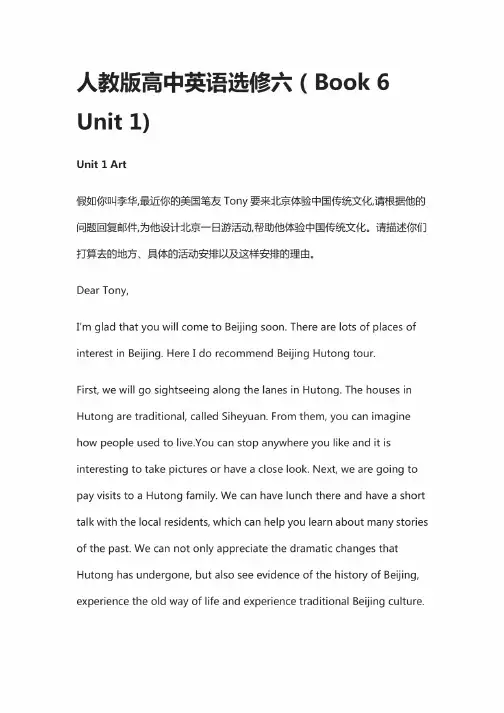
人教版高中英语选修六(Book6 Unit1)Unit1Art假如你叫李华,最近你的美国笔友Tony要来北京体验中国传统文化,请根据他的问题回复邮件,为他设计北京一日游活动,帮助他体验中国传统文化。
请描述你们打算去的地方、具体的活动安排以及这样安排的理由。
Dear Tony,I'm glad that you will come to Beijing soon.There are lots of places of interest in Beijing.Here I do recommend Beijing Hutong tour.First,we will go sightseeing along the lanes in Hutong.The houses in Hutong are traditional,called Siheyuan.From them,you can imagine how people used to live.You can stop anywhere you like and it is interesting to take pictures or have a close look.Next,we are going to pay visits to a Hutong family.We can have lunch there and have a short talk with the local residents,which can help you learn about many stories of the past.We can not only appreciate the dramatic changes that Hutong has undergone,but also see evidence of the history of Beijing, experience the old way of life and experience traditional Beijing culture.In a word,Hutongs are the homes of common people in the past.It is easy to know how people lived and had fun in the old days.So it is a good choice to learn about traditional Chinese culture.I'm looking forward to your coming.Yours,Li Hua1.文章体裁:应用文——电子邮件。

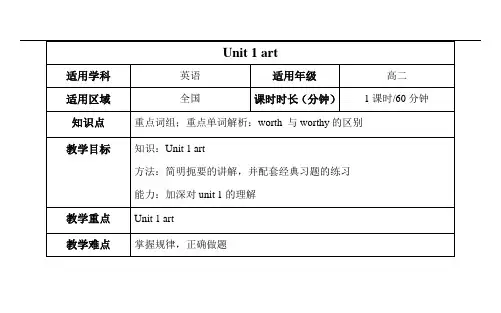
教学过程一、课堂导入先播放unit 6的课文磁材,让学生带着问题去听,提升听力,又对文章有一个先行的理解。
二、复习预习复习上一单元的知识点之后,以达到复习的效果。
然后给学生一些相关的单选或其他类型题目,再老师没有讲解的情况下,让学生独立思考,给出答案与解释,促进学生发现问题,同时老师也能发现学生的盲点,并能有针对性地进行后面的讲课。
三、知识讲解知识点1:重点词组1. in the abstract 抽象地,理论上abstract sth. from sth. 从…中提取…2. as well as 也,同,和;同…一样3. aim at sth. 瞄准aim to do sth. 意欲,企图做某事aim at doing sth.with the aim of 带有……的目的4. focus on=concentrate on 集中5. convince sb.of 使某人信服6. a great deal 大量7. in the flesh 活着的8. take the place of sb. = replace 代替,取代take one’s place代替,取代;入座;就位9. break away from 脱离,摆脱,放弃10. at the same time 同时;但是11. would rather do sth (主语)宁愿做某事would rather sb. did sth. 宁愿某人做某事(现在或将来)would rather sb. had done sth. 宁愿某人做某事(过去)12. as a consequence =in consequence = as a result 结果as a consequence of =in consequence of =as a result of 由于…的原因13. in possession of 拥有…in the possession of sb =in one’s possession为某人所拥有take/ have possession of 拥有(占有)14. consider doing 考虑做某事consider sb./sth. to be/asconsider that-clause 认为,看待consider it adj./n.+to do sth.15. be well worth doing 值得…(表被动)16. be contemporary with 与…属同时期17. convince sb. of sth 使某人确信/明白某事convince sb. +that clause 使某人相信…convince sb.to do sth. 说服某人做某事知识点2:重点单词讲解worth与worthy的区别worth与worthy都是作“值得”讲的形容词,但在使用上和与词的搭配关系上都不相同。
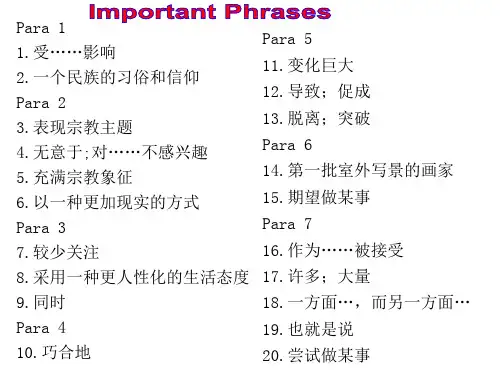

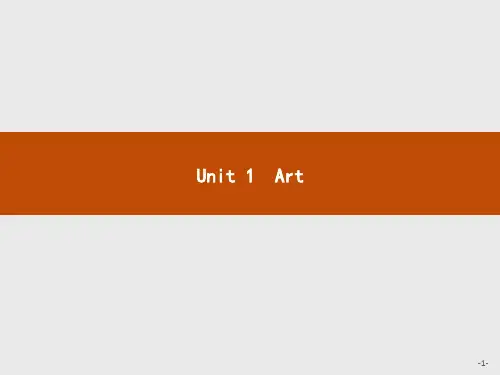
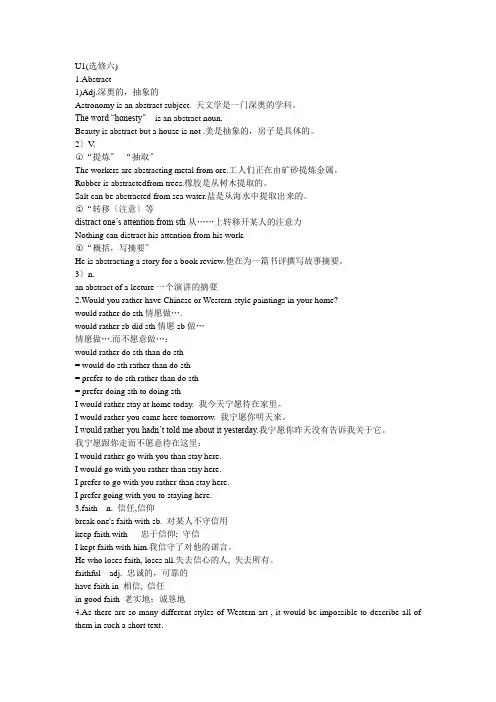
U1(选修六)1.Abstract1)Adj.深奥的,抽象的Astronomy is an abstract subject. 天文学是一门深奥的学科。
The word “honesty〞is an abstract noun.Beauty is abstract but a house is not .美是抽象的,房子是具体的。
2〕V.○1“提炼〞“抽取〞The workers are abstracting metal from ore.工人们正在由矿砂提炼金属。
Rubber is abstractedfrom trees.橡胶是从树木提取的。
Salt can be abstracted from sea water.盐是从海水中提取出来的。
○2“转移〔注意〕等distract one’s attention from sth从……上转移开某人的注意力Nothing can distract his attention from his work.○3“概括,写摘要〞He is abstracting a story for a book review.他在为一篇书评撰写故事摘要。
3〕n.an abstract of a lecture一个演讲的摘要2.Would you rather have Chinese or Western-style paintings in your home?would rather do sth情愿做….would rather sb did sth情愿sb做…情愿做….而不愿意做…:would rather do sth than do sth= would do sth rather than do sth= prefer to do sth rather than do sth= prefer doing sth to doing sthI would rather stay at home today. 我今天宁愿待在家里。
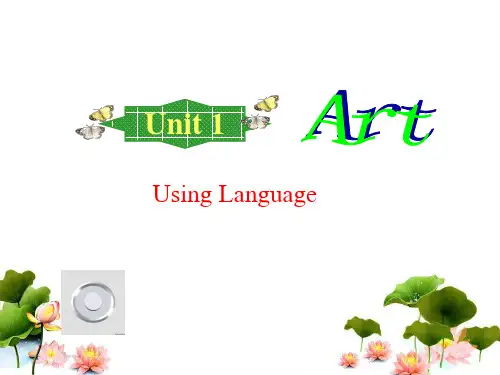


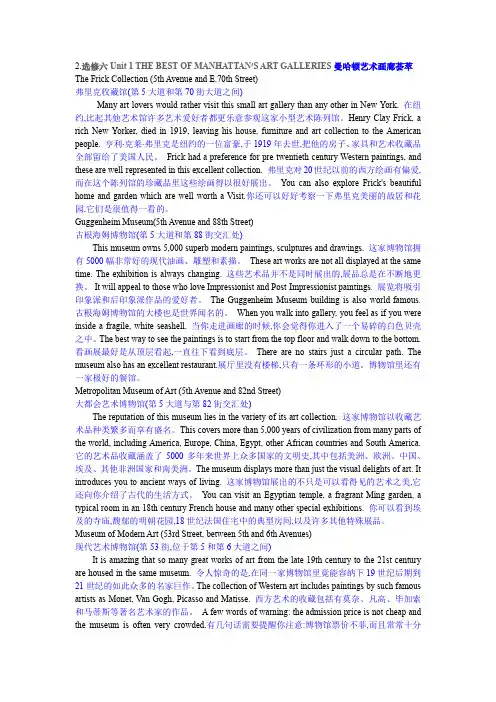
2.选修六Unit 1 THE BEST OF MANHATTAN’S ART GALLERIES曼哈顿艺术画廊荟萃The Frick Collection (5th Avenue and E.70th Street)弗里克收藏馆(第5大道和第70街大道之间)Many art lovers would rather visit this small art gallery than any other in New York. 在纽约,比起其他艺术馆许多艺术爱好者都更乐意参观这家小型艺术陈列馆。
Henry Clay Frick, a rich New Yorker, died in 1919, leaving his house, furniture and art collection to the American people. 亨利·克莱·弗里克是纽约的一位富豪,于1919年去世,把他的房子、家具和艺术收藏品全部留给了美国人民。
Frick had a preference for pre-twentieth century Western paintings, and these are well-represented in this excellent collection. 弗里克对20世纪以前的西方绘画有偏爱,而在这个陈列馆的珍藏品里这些绘画得以很好展出。
You can also explore Frick's beautiful home and garden which are well worth a Visit.你还可以好好考察一下弗里克美丽的故居和花园,它们是很值得一看的。
Guggenheim Museum(5th Avenue and 88th Street)古根海姆博物馆(第5大道和第88街交汇处)This museum owns 5,000 superb modern paintings, sculptures and drawings. 这家博物馆拥有5000幅非常好的现代油画、雕塑和素描。
Unit 1 Living wellTeaching aims(教学目标)三维目标知识目标Knowledge aims:1.Key words and phrases in this unit: abstract(抽象的),sculpture(雕塑),gallery(画廊),faith(信念),aim(目标),conventional(传统的),typical(典型的,有代表性的),evident(明显的),adopt(采用),possess(拥有),superb(卓越的,杰出的),possession(财产),technique(技术),by coincidence(巧合地),a great deal(大量),shadow(阴影),ridiculous(可笑的),controversial(争议的),attempt(尝试;企图),on the other hand(另一方面),predict(预测).2.To learn about some major movements in Western art and how art has changed stylistically over the centuries.3.To learn how the information is organized.4.To develop the students' reading ability by skimming and scanning the passage. 5.To develop the students' speaking ability by talking about Western paintings. 6.To get the students to understand and use the following important and useful sentence patterns:If you could have three of these paintings on the walls of your classrooms,which would you choose?If you were an artist,what kind of pictures would you paint?Grammar in this unit: 虚拟语气(Subjunctive Mood)能力目标Ability aims:1.To learn about some major movements in Western art and how art has changed stylistically over the centuries.2.To guess what will be talked about in the listening materials.3.To improve their reading skills.4. Develop students’ reading ability and let them learn different reading skills.情感目标1.To stimulate students' sense of beauty and the ability of understanding,enjoying and creating beauty.2.To develop students' sense of cooperative learning.3. Activate the students’interest of learning English by using many kinds ofclassroom activities.Important points(教学重点)1. How to gain the ability to use the key words and expressions from the context.2.Get students to know about Western painting and Chinese art,famous artists and works of art.3.Enable students to grasp and use the expressions of preference.4.Let students learn the new grammar item:the subjunctive mood(1).5.Develop students' listening,speaking,reading and writing ability.2. Understanding the listening materials.Difficult points(教学难点)1. Get students to learn different reading skills.2.Enable students to master the use of the subjunctive mood.3.Let students learn to write a letter of suggestion.Teaching methods(教学方法)1. Task-based teaching and learning2. Cooperative learning and practice3.Asking-and-answering activity to check the students’ answers of the exercises;individual,pair or group work to finish each task.4. Fast and careful reading.5. Discussion.Teaching aids(教具)(1)a tape recorder(2)a projector(3)the blackboard、whiteboard and other normal teaching tools学法指导合作探究对话推理教材分析本单元的中心话题是西方绘画艺术的历史、中西方各种艺术形式与风格,各时代的著名画家以及他们的作品。
高中英语人教版选修6第一单元教案Unit 1 ArtPeriod 1Warming up1. Warming up⑴Warming up by talking about what paining isHello, everyone. Today we shall read a passage entitled A SHORT HISTORY OF WESTERN PAINTING. But first what do you know about painting? Could anyone stand up to tell the class something about painting?⑵Warming up by talking about Chinese paintingBefore we read about the western painting let’s talk a bit about Chinese painting. How much do you know about Chinese painting? Have you ever seen any famous Chinese paintings?You may use words like Chinese Paint, Wall paintings, the hanging scroll, aesthetic values and tastes to express your views.⑶Warming up by looking at and saying about Mona LisaHello, class. Before we read about western painting, we shall look at one of themasterpieces by one of the western painters.Mona Lisa, or La Gioconda (La Joconde), is a 16th-century oil painting on poplar wood by Leonardo da Vinci, and is arguably the most famous painting in the world. Few works of art have been subject to as much scrutiny, study, mythologizing and parody. It is owned by the French government and hangs in the Musée du Louvre in Paris.The painting, a half-length portrait, depicts a woman whose gaze meets the viewer's with an expression often described as enigmatic.Period 2 ReadingObjectives■T o help students learn to make reference■T o help students learn to read an exposition about western painting■T o help students better understand “art”■T o help students learn to use some important words and expressions■T o help students identify examples of “Subjunctive Mood (1) I wish I could/ did/ would… If I did …, I would do…” in the text FocusAidsMultimedia facilities, tape-recorder, photos, diagramsStep1 GreetingStep2 IntroductionIn this period, after the warming up, students will first be guided to talk about galleries。
⼈教版新课标2019-2020年选修六第⼀单元Unit1Art单元综合测评含答案Unit 1 Art单元综合测评(时间:100分钟分值:120分)选择题部分Ⅰ.阅读理解(共两节,满分35分)第⼀节(共10⼩题;每⼩题2.5分,满分25分)阅读下列短⽂,从每题所给的A、B、C和D四个选项中,选出最佳选项。
AAs long as I can remember, I’ve always loved to draw. But my interest in drawing wasn’t encouraged very much. Growing up in the 1950s, in Grand Rapids, Michigan, boys were supposed to be athletic. Certain peer pressures encouraged little fingers to learn how to hold footballs rather than crayons.My early love for drawing developed into a love for telling stories through pictures. Stories began as fragments (⽚段) of pictures in my mind. I created a story by posing questions to myself. I called it the “what if” and “what then” approach. For example, for my book The Polar Express, I started out by thinking “What if a boy gets on that train? Where does he go?”From the time I come up with the idea, write and illustrate the book, and deliver it to the printer, it takes about seven months. Firstly, I begin thinking of the idea. Then I imagine the pictures and the story. A good picture book should have events that are visually arresting. I first consider scenes that are exciting to look at and then my challenge is to weave a story around those pictures. The next step is putting the illustrations and story down on paper.When you first look at my illustrations, you see ordinary, everyday things. But if you look closer, things might not seem quite so simple. When I’m writing a book, I always try to create something strange or puzzling in each picture. By using artistic strategies, I can give the drawing a kind of mysterious quality.All of my books are picture books, so they are generally thought of as books for children. But when I make them, I think of the books as being for everybody—for people of all ages. When I was a kid, I had no idea what I wanted to be when I grew up, but now I’m really glad I became an artist and a storyteller.1.Why does the author mention The Polar Express?A.To tell us an interesting story.B.To introduce his famous work.C.To make up a sentence with “what if”.D.To show us how he designed his book.2.The underlined word “arresting” in Paragraph 3 probably means “”.A.frighteningB.interestingC.satisfyingD.worrying3.What would be the best title for this passage?A.Telling stories by drawingB.“What if” and “what then”C.How to tell interesting storiesD.Working as a famous storytellerBRecently, a painting of actress Elizabeth Taylor, which was drawn by American artist and film-maker Andy Warhol, sold for $63 million. Another simple black-and-white image of a Coca-Cola bottle sold for $35 million. But the all-time record for a Warhol painting is $100 million for a piece titled Eight Elvises. What’s amazing is not that the pieces sold for so much, but the fact that they are not what you would call traditional art. They are “pop art”, art based on simple images of things and people from adv ertising, movies, music and day-to-day life.Born in the 1920s, Warhol grew up mostly separated from other children due to health problems. He spent a lot of his time alone drawing and then went on to study art in college. He began his career as a commercial artist, creating pictures for magazine articles and newspaper ads. That inspired him to experiment with pop art and he hosted America’s first pop art exhibition in the 1960s. The show met with a lot of discussion with some people saying that what he was doing was not art. Warhol followed his first works with a series we are all familiar with—paintings of Coca-Cola bottles, Brillo soap pad boxes, and portraits (肖像) of famous people. Soon after, Warhol stopped creating his own artwork. Instead, he had assi stants and other artists create them at his studio called “The Factory”. Warhol wanted to show the world that art doesn’t have to be complex or original; it can be created by anyone using ordinary things.Today, Warhol’s work is unmistakable in its uniqueness. No matter how you may feel about his work, one thing cannot be argued. He introduced the world to a whole new art form, inspiring future generations of artists, and eventually becoming one of the most famous and successful pop art artists in the world.4. Which of the following pictures sold for $100 million?A B C D5. During his childhood, Warhol .A.drew pictures for magazinesB.always lived a lonely lifeC.showed no interest in artD.liked to paint and dance6. Calling his studio “The Factory”, Warhol tried to show .A.his studio was as big as a factoryB.pop art is different from traditional artC.artists prefer to work in a factoryD.art should be simple and easy to produceCThis year, the Paris museum that looks like a jumble (杂乱的⼀堆) of giant, coloured pipes turns 40. The museum—the Pompidou Centre—has a secure place in the heart of Paris and in Parisians’hearts. But it isn’t always the case.“When it was first built, the reaction was one of disbelief,” said Serge Lasvignes, president of the Pompidou Centre. “Le Monde newspaper wrote the museum’s construction brought shame on Paris, and city politicians thought their money had been totally wasted,” said Lasvignes. Critic s said it looked like an oil refinery(炼油⼚).France’s first museum entirely devoted to contemporary art saw the light of day thanks to the determination of one man—Georges Pompidou, an art-lover who served as France’s president from 1969 to 1974.In 1971, he started an international competition to build the museum, originally known as the Centre Beaubourg. The winning team, which included three young architects from Britain and Italy, was completely unknown at the time. Renzo Piano and Richard Rogers, the two architects who saw the project through, made the plan a reality.“They didn’t think they had a chance to win. So they thought they might as well do exactly what they wanted,” Lasvignes said.“The design took everyone by surprise and it was completely di fferent from any other museum. Someone said to Piano, ‘Your thing is terrible—with the escalator (⾃动扶梯) on the outside, it looks like a supermarket!’” Lasvignes added.Forty years later, the museum still tries to make culture available to everyone, Lasvignes said. He calls the Pompidou Centre a museum like no other. “We are not only a museum,” he said. “We have concerts, debates, performances, a library…and everything flows together.” Pompidou felt putting up walls between different forms of art was harmful. “So we are a house of culture where people return again and again,” Lasvignes said.The Pompidou Centre is Europe’s biggest modern art museum; New York’s Museum of Modern Art (MoMA) is the biggest in the world. “But the two museums have totally different strategies (策略),” Lasvignes said. “The MoMA’s strategy is to collect masterpieces, and we try to represent an entire epoch(时代).”7.What was people’s attitude to the Pompidou Centre at first?A. They disliked it.B.They respected it.C. They were curious about it.D.They paid little attention to it.8.Who completed the construction of the Paris museum?A. President of the Centre Beaubourg.B. Three unknown French architects.C. Georges Pompidou.D. Piano and Rogers.9.What was the Pompidou Centre like in Lasvignes’ eyes?A. Very solid.B. Quite traditional.C. Entirely original.D. Extremely simple.10.Which is a notable feature of the Pompidou Centre?A. It collects great masterpieces.B. It holds various cultural events.C. It is the world’s biggest art museum.D. It is particularly attractive to foreigners.第⼆节(共5⼩题;每⼩题2分,满分10分)根据短⽂内容,从短⽂后的选项中选出能填⼊空⽩处的最佳选项。
Unit 1 Art I.单元教学目标技育铉目标Skill Goals▲Talk about art and galleries▲Talk about likes and preferences▲Learn words in families▲Use the subjunctive mood▲Write a letter to give suggestionsII.目标语言m.教材分析与教材重组i.教材分析本单元以Art为主题,主要介绍了西方绘画简史,描写了曼哈顿最好的艺术长廊。
帮助学生了解更多有关美术的背景知识,分析中四方艺术史上各大流派的特点,指出其代表性的画家和作品,并对中西方绘画艺术进行比较。
最后要求学生为当地举办的一场别开生面的画展提岀合理化建议。
1.1Warming Up部分要求学生运用相关的目标语言对自己所喜欢的艺术形式和艺术流派展开讨论,并说明喜欢的原因。
1.2Pre-reading让学生讨论有关画展或书中的艺术作品以及西方不同历史时期的著名画家。
1.3Reading介绍了西方绘画简史上不同历史时期的艺术流派、艺术特点及其代表性的Iffll家和作品等。
1.4Comprehending要求学生在理解课文的基础上,写出三件有关西方艺术史的事并指出西方艺术风格变化大的原因。
1.5Learning about Language 由Discovering useful words and expressions 和Discovering useful structures两部分组成。
要求学生对课文进行概括和总结,找岀所提供单词的词根,并学习虚拟语气在条件状语从句中的运用。
1.6Using Language 是由Reading, Listening and speaking 和Writing 三部分组成,通过对学生听说读写综合能力的培养,要求学生在了解艺术长廊相关知识的慕础上,为当地举办的一场别开生面的画展提出合理化建议。